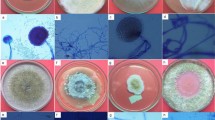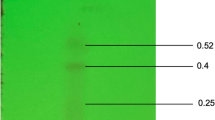Abstract
Objective
To isolate antifungal compound from Paeonia suffruticosa, and to find the antifungal mechanisms by observing the ultrastructural modifications of yeasts in growth phase produced by 1,2,3,4,6-penta-O-galloyl-beta-D-glucose (PGG).
Methods
Peony (Paeonia suffruticosa) root bark (PRB) was separated by solvent extraction and purified by high performance liquid chromatography (HPLC) method using analytical and preparative reversed phase C18 column on the basis of bio-assay method. In order to investigate the antifungal mechanism of PGG, Yeasts were submitted to different concentrations [3 × minimum inhibition concentration (MIC), 0.3 × MIC] for 1 h under constant stirring at 30 °C, and transmission electron microscopy was performed.
Results
Based on the antifungal activity of PRB on Candida glabrata CBS138, the antifungal compound were isolated in ethyl acetate layer of PRB and identified as PGG by mass spectrometry, 1H nuclear magnetic resonance (NMR) analyses, with molecular weight of 940 and molecular formular as C41H32O26. Transmission electron microscopy showed that PGG degraded the cell wall envelope.
Conclusion
The results suggest that PGG may be responsible for the antifungal activity of PRB by disrupting the structure of cell wall directly.
Similar content being viewed by others
References
Silva S, Negri M, Henriques M, Oliveira R, Williams DW, Azeredo J. Candida glabrata, Candida parapsilosis and Candida tropicalis: biology, epidemiology, pathogenicity and antifungal resistance. FEMS Microbiol Rev 2012;36:288–305.
Pfaller MA, Moet GJ, Messer SA, Jones RN, Castanheira M. Geographic variations in species distribution and echinocandin and azole antifungal resistance rates among Candida bloodstream infection isolates: report from the SENTRY Antimicrobial Surveillance Program (2008 to 2009). J Clin Microbiol 2011;49:396–399.
Fidel PL Jr, Vazquez JA, Sobel JD. Candida glabrata: review of epidemiology, pathogenesis, and clinical disease with comparison to C. albicans. Clin Microbiol Rev 1999;12:80–96.
Pfaller MA, Castanheira M, Lockhart SR, Ahlquist AM, Messer SA, Jones RN. Frequency of decreased susceptibility and resistance to echinocandins among fluconazole-resistant bloodstream isolates of Candida glabrata. J Clin Microbiol 2012;50:1199–1203.
Yoshikawa M, Uchida E, Kawaguchi A, Kitagawa I, Yamahara J. Galloyl-oxypaeoniflorin, suffruticosides A, B, C, and D, five new antioxidative glycosides, and suffruticoside E, A paeonol glycoside, from Chinese moutan cortex. Chem Pharm Bull (Tokyo) 1992;40:2248–2250.
Yoshikawa M, Ohta T, Kawaguchi A, Matsuda H. Bioactive constituents of Chinese natural medicines. V. Radical scavenging effect of Moutan Cortex. (1): Absolute stereostructures of two monoterpenes, paeonisuffrone and paeonisuffral. Chem Pharm Bull (Tokyo) 2000;48:1327–1331.
Matsuda H, Ohta T, Kawaguchi A, Yoshikawa M. Bioactive constituents of chinese natural medicines. VI. Moutan cortex. (2): structures and radical scavenging effects of suffruticosides A, B, C, D, and E and galloyloxypaeoniflorin. Chem Pharm Bull (Tokyo) 2001;49:69–72.
Kim SH, Kim SA, Park MK, Park YD, Na HJ, Kim HM, et al. Paeonol inhibits anaphylactic reaction by regulating histamine and TNF-alpha. Int Immunopharmacol 2004;4:279–287.
Hirai A, Terano T, Hamazaki T, Sajiki J, Saito H, Tahara K, et al. Studies on the mechanism of antiaggregatory effect of Moutan Cortex. Thromb Res 1983;31:29–40.
Sakamoto S, Yoshino H, Shirahata Y, Shimodairo K, Okamoto R. Pharmacotherapeutic effects of kuei-chih-fuling-wan (keishi-bukuryo-gan) on human uterine myomas. Am J Chin Med 1992;20:313–317.
Harper JI, Yang SL, Evans AT, Evans FJ, Phillipson JD. Chinese herbs for eczema. Lancet 1990;335:795.
Ikuta A, Kamiya K, Satake T, Saiki Y. Triterpenoids from callus tissue cultures of paeonia species. Phytochemistry 1995;38:1203–1207.
Lin HC, Ding HY, Wu YC. Two novel compounds from Paeonia suffructicosa. J Nat Prod 1998;61:343–346.
Chuang WC, Lin WC, Sheu SJ, Chiou SH, Chang HC, Chen YP. A comparative study on commercial samples of the roots of Paeonia vitchii and P. lactiflora. Plant Med 1996;62:347–351.
Wang X, Cheng C, Sun Q, Li F, Liu J, Zheng C. Isolation and purification of four flavonoid constituents from the flowers of Paeonia suffruticosa by high-speed counter-current chromatography. J Chromatogr A 2005;1075:127–131.
Ishida H, Takamatsu M, Tsuji K, Kosuge T. Studies on active substances in herbs used for oketsu (“stagnant blood”) in Chinese medicine. V. On the anticoagulative principle in Moutan Cortex. Chem Pharm Bull (Tokyo) 1987;35:846–848.
Institute CaLS. Reference method for broth dilution antifungal susceptibility testing of yeasts, 3rd ed. Approved standard M27-A3. ed. Clinical and Laboratory Standards Institute. Wayne: Clinical and Laboratory Standards Institute; 2008.
He Q, Ge ZW, Song Y, Cheng YY. Quality evaluation of cortex moutan by high performance liquid chromatography coupled with diode array detector and electrospary ionization tandem mass spectrometry. Chem Pharm Bull (Tokyo) 2006;54:1271–1275.
Vandeputte P, Tronchin G, Rocher F, Renier G, Berges T, Chabasse D, et al. Hypersusceptibility to azole antifungals in a clinical isolate of Candida glabrata with reduced aerobic growth. Antimicrob Agents Chemother 2009;53:3034–3041.
Nishizawa M, Yamagishi T. Tannins and related compounds. Part 5. Isolation and characterization of polygalloylglucoses from Chinese gallotannin. J Chem Soc, Perkin Trans 1 1982:2963–2968.
An RB, Kim HC, Lee SH, Jeong GS, Sohn DH, Park H, et al. A new monoterpene glycoside and antibacterial monoterpene glycosides from Paeonia suffruticosa. Arch Pharm Res 2006;29:815–820.
Lee TO, Khan Z, Kim SG, Kim YH. Amendment with peony root bark improves the biocontrol efficacy of Trichoderma harzianum against Rhizoctonia solani. J Microbiol Biotechnol 2008;18:1537–1543.
Hagerman AE, Rice ME, Ritchard NT. Mechanisms of protein precipitation for two tannins, pentagalloyl glucose and epicatechin16 (4→8) catechin (procyanidin). J Agric Food Chem 1998;46:2590–2595.
Nguyen KT, Ta P, Hoang BT, Cheng S, Hao B, Nguyen MH, et al. Characterising the post-antifungal effects of micafungin against Candida albicans, Candida glabrata, Candida parapsilosis and Candida krusei isolates. Int J Antimicrob Agents 2010;35:80–84.
Moulin-Traffort J, Steinmetz MD, Rascol JP, Regli P. Effects of Pycnoporellus fulgens (Fr.) Donk crude extract on Candida glabrata ultrastructure. Mycoses 1999;42:273–279.
Zhang J, Li L, Kim SH, Hagerman AE, Lu J. Anticancer, anti-diabetic and other pharmacologic and biological activities of penta-galloyl-glucose. Pharm Res 2009;26:2066–2080.
Zhang F, Luo SY, Ye YB, Zhao WH, Sun XG, Wang ZQ, et al. The antibacterial efficacy of an aceraceous plant [Shantung maple (Acer truncatum Bunge)] may be related to inhibition of bacterial beta-oxoacyl-acyl carrier protein reductase (FabG). Biotechnol Appl Biochem 2008;51:73–78.
Author information
Authors and Affiliations
Corresponding author
Additional information
Supported in part by a grant from Bureau of Personnel of Beijing (No. 100005)
Rights and permissions
About this article
Cite this article
Zhao, Y., Wang, Be., Zhang, Sw. et al. Isolation of antifungal compound from Paeonia suffruticosa and its antifungal mechanism. Chin. J. Integr. Med. 21, 211–216 (2015). https://doi.org/10.1007/s11655-014-1805-7
Received:
Published:
Issue Date:
DOI: https://doi.org/10.1007/s11655-014-1805-7




